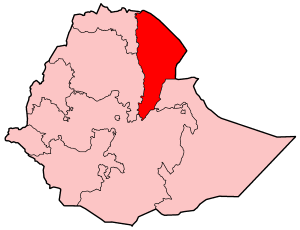|
Middle Awash Project
The Middle Awash Project is an international research expedition conducted in the Afar Region of Ethiopia with the goal of determining the origins of humanity. The project has the approval of the Ministry of Culture and Tourism (Ethiopia), Ethiopian Culture Ministry and a strong commitment to developing Ethiopian archaeology, paleontology and geology research infrastructure. This project has discovered over 260 fossil specimens and over 17,000 vertebrate fossil specimens to date ranging from 200,000 to 6,000,000 years in age. Researchers have discovered the remains of four hominin species, the earliest subspecies of homo sapiens as well as stone tools. All specimens are permanently held at the National Museum of Ethiopia, where the project's laboratory work is conducted year round. Geography The Middle Awash Project takes place in a semi arid, rather remote part of the Afar rift. Between 5.8 and 4.4 Ma, the region was grassland and wetland. Today, the rift is a basin divided b ... [...More Info...] [...Related Items...] OR: [Wikipedia] [Google] [Baidu] [Amazon] |
Afar Region
The Afar Region (; ; ), formerly known as Region 2, is a Regions of Ethiopia, regional state in northeastern Ethiopia and the homeland of the Afar people. Its capital is the planned city of Semera, which lies on the paved Awash, Ethiopia, Awash–Assab highway. It is bordered by Eritrea to the north and Djibouti to the northeast; it also shares regional borders with the Tigray Region, Tigray, Amhara Region, Amhara, Oromia, Oromo and Somali Region, Somali regions. The Afar Triangle, the northern part of which is the Danakil Depression, is part of the Great Rift Valley, Ethiopia, Great Rift Valley of Ethiopia, and is located in the north of the region. It has the lowest point in Ethiopia and one of the lowest in Africa. The southern part of the region consists of the valley of the Awash River, which empties into a string of lakes along the Djibouti–Ethiopia border. Other notable landmarks include the Awash National Park. Demographics Based on the 2017 projections by the Centra ... [...More Info...] [...Related Items...] OR: [Wikipedia] [Google] [Baidu] [Amazon] |
Ethiopia
Ethiopia, officially the Federal Democratic Republic of Ethiopia, is a landlocked country located in the Horn of Africa region of East Africa. It shares borders with Eritrea to the north, Djibouti to the northeast, Somalia to the east, Kenya to the south, South Sudan to the west, and Sudan to the northwest. Ethiopia covers a land area of . , it has around 128 million inhabitants, making it the List of countries and dependencies by population, thirteenth-most populous country in the world, the List of African countries by population, second-most populous in Africa after Nigeria, and the most populous landlocked country on Earth. The national capital and largest city, Addis Ababa, lies several kilometres west of the East African Rift that splits the country into the African Plate, African and Somali Plate, Somali tectonic plates. Early modern human, Anatomically modern humans emerged from modern-day Ethiopia and set out for the Near East and elsewhere in the Middle Paleolithi ... [...More Info...] [...Related Items...] OR: [Wikipedia] [Google] [Baidu] [Amazon] |
Ministry Of Culture And Tourism (Ethiopia)
The Ministry of Culture and Tourism (Amharic: የባህልና ቱሪዝም ሚኒስቴር) is the Ethiopian government department responsible for not researching, preserving, developing, and promoting the culture and tourist attractions of Ethiopia and its peoples, both inside the country and internationally. In doing so the Ministry closely works together with different national and international stakeholders. Overview The Ministry of Culture and Tourism is responsible for developing and promoting tourism in Ethiopia, and to boost sustainable socio-economic and political values with popular and stakeholder's participation. Subordinate bodies include the Authority for Research and Conservation of Cultural Heritage (ARCCH), Ethiopian Wildlife Conservation Authority (EWCA), National Archives and Library Agency, and Ethiopian National Theatre. The Ministry publicizes the country's resources of tourist attractions and encourages the development of tourist facilities. It als ... [...More Info...] [...Related Items...] OR: [Wikipedia] [Google] [Baidu] [Amazon] |
Jon Kalb (cropped)
Jon Kalb August 17, 1941 (Houston, Texas) - October 27, 2017 (Austin, Texas) was a research geologist with the Vertebrate Paleontology Laboratory (Texas Memorial Museum), University of Texas at Austin. He received a pre-doctoral fellowship from the Carnegie Geophysical Laboratory in 1968, a graduate fellowship from Johns Hopkins University in 1969, and a BSc from American University in 1970. Early experience As a teenager Kalb began his career with a Mexican-American expedition searching for early shipwrecks off the coast of the Yucatan. He later joined famed treasure hunter and marine archeologist Bob Marx exploring reefs in the Caribbean. Sidelined by injuries from diving, Kalb was sent to the west coast of South America by the Smithsonian to collect marine fauna. He then joined a team of geologists with the U.S. Army Corps of Engineers in northwest Colombia mapping a potential route for a sea-level canal, which led him to prospect for gold on the Guinean Shield for the Guya ... [...More Info...] [...Related Items...] OR: [Wikipedia] [Google] [Baidu] [Amazon] |
Michele Gortani
Michele Gortani (16 January 1883 – 24 January 1966) was an Italian geologist, entomologist, and politician. He was a specialist on the Carnian Alps where he grew up and worked for much of his life. Gortani was born in Friuli to engineer Luigi and Angela Grassi in Lugo, Spain where his father then worked. He was educated at Udine before joining Bologna University, graduating in 1904. He was keenly interested in the Alpine region of Carnia, taking an interest in flora, paleontology, and entomology. He published on the fossils of Carnia while still a student in 1902. He worked as a geological assistant at Perrugia University in 1905 and at Bologna from 1906 to 1910, and Turin (1911–1913). He married Maria Gentile Mencucci from Zuglio in 1911. He became a professor at Pisa University in 1913 and also became a deputy in the Italian parliament in the same year. He volunteered in the Alpini (Alpine troops) during World War I and was court-martialled for criticising the Italian Army ... [...More Info...] [...Related Items...] OR: [Wikipedia] [Google] [Baidu] [Amazon] |
Ardipithecus Kadabba
''Ardipithecus kadabba'' is the scientific classification given to fossil remains "known only from teeth and bits and pieces of skeletal bones", originally estimated to be 5.8 to 5.2 million years old, and later revised to 5.77 to 5.54 million years old. According to the first description, these fossils are close to the common ancestor of chimps and humans. Their development lines are estimated to have parted 6.5–5.5 million years ago. It has been described as a "probable chronospecies" (i.e. ancestor) of '' A. ramidus''. Although originally considered a subspecies of ''A. ramidus'', in 2004 anthropologists Yohannes Haile-Selassie, Gen Suwa, and Tim D. White published an article elevating ''A. kadabba'' to species level on the basis of newly discovered teeth from Ethiopia. These teeth show "primitive morphology and wear pattern" which demonstrate that ''A. kadabba'' is a distinct species from ''A. ramidus''. The specific name comes from the Afar word for "basal family a ... [...More Info...] [...Related Items...] OR: [Wikipedia] [Google] [Baidu] [Amazon] |
Ardipithecus Ramidus
''Ardipithecus ramidus'' is a species of australopithecine from the Afar region of Early Pliocene Ethiopia 4.4 million years ago (mya). The species ''A. ramidus'' is the type species for the genus ''Ardipithecus''. There is an older species in this same genus, ''Ardipithecus kadabba''. ''A. ramidus'', unlike modern hominids, has adaptations for both walking on two legs (bipedality) and life in the trees (arboreality). However, it would not have been as efficient at bipedality as humans, nor at arboreality as non-human great apes. Its discovery, along with Miocene apes, has reworked academic understanding of the chimpanzee–human last common ancestor from appearing much like modern-day chimpanzees, orangutans and gorillas to being a creature without a modern analogue. The facial anatomy (specifically the reduced sexual dimorphism of the canines) suggests that ''A. ramidus'' males were less aggressive than those of modern chimps, which is correlated to increased parental care an ... [...More Info...] [...Related Items...] OR: [Wikipedia] [Google] [Baidu] [Amazon] |
Australopithecus Anamensis
''Australopithecus anamensis'' is a hominin species that lived roughly between 4.3 and 3.8 million years ago, and is the oldest known ''Australopithecus'' species, Nearly 100 fossil specimens of ''A. anamensis'' are known from Kenya and Ethiopia, representing over 20 individuals. The first fossils of ''A. anamensis'' discovered are dated to around 3.8 and 4.2 million years ago and were found in Kanapoi and Allia Bay in northern Kenya. '' A. afarensis'' is normally accepted to have emerged within this lineage. However, ''A. anamensis'' and ''A. afarensis'' appear to have lived side-by-side for at least some period of time, and whether the lineage that led to extant humans emerged in ''A. afarensis'', or directly in ''A. anamensis'' is not fully settled. Fossil evidence determines that ''Australopithecus anamensis'' is the earliest hominin species in the Turkana Basin, but likely co-existed with ''afarensis'' towards the end of its existence. ''A. anamensis'' and ''A. afarensis'' ... [...More Info...] [...Related Items...] OR: [Wikipedia] [Google] [Baidu] [Amazon] |



